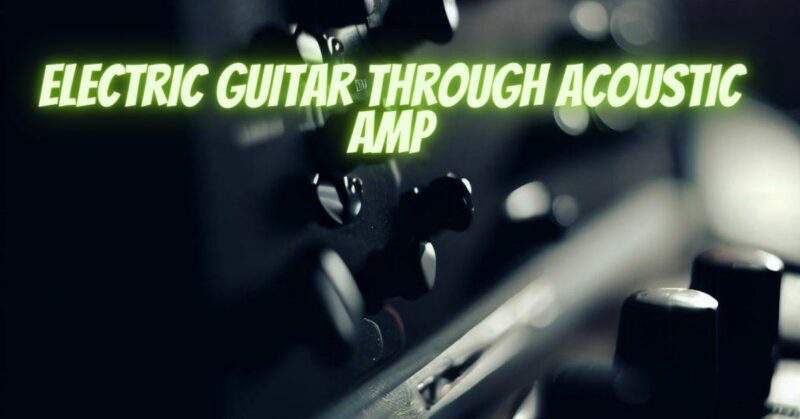The world of music is rife with experimentation and creativity, often leading musicians to explore unconventional combinations of instruments and equipment. Amplifying an electric guitar through an acoustic amp is one such exploration, offering a unique sonic experience that combines the characteristics of both instruments. In this article, we’ll delve into the practice of using an acoustic amp to amplify an electric guitar, discussing the possibilities, challenges, and creative outcomes that can arise from this intriguing approach.
Understanding Acoustic Amps
Acoustic amps are designed to accurately reproduce the natural sound of acoustic instruments, such as acoustic guitars, violins, and mandolins. They prioritize transparency, clarity, and tonal accuracy, aiming to capture the nuances of acoustic instruments’ resonance and harmonics.
Using an Electric Guitar with an Acoustic Amp
1. Sonic Characteristics:
Amplifying an electric guitar through an acoustic amp can lead to interesting tonal qualities. The transparency of acoustic amps can bring out the inherent characteristics of the electric guitar, including its pickups, strings, and construction.
2. Clarity and Definition:
Acoustic amps emphasize clarity and definition, which can result in a focused and detailed representation of the electric guitar’s sound. This can be particularly advantageous for intricate playing styles and clean tones.
3. Dynamic Response:
Acoustic amps often have a dynamic response that reacts to the nuances of your playing. This can lead to expressive dynamics and tonal variations, enhancing your control over the electric guitar’s sound.
4. Unique Overtones:
The combination of electric guitar components and acoustic amp transparency can yield unique overtones and harmonics that might not be as pronounced with traditional electric guitar amplification.
Challenges and Considerations
1. Tonality and Distortion:
Using an electric guitar with an acoustic amp might not provide the same level of distortion and effects versatility as dedicated electric guitar amps. Experiment with pedal effects to achieve desired tones.
2. Feedback:
Acoustic amps are designed to be feedback-resistant for acoustic instruments. When using an electric guitar with high-gain settings, feedback might become an issue, requiring adjustments to amplifier settings.
3. Speaker Configuration:
Acoustic amps often feature full-range speakers that might not emphasize certain frequencies associated with electric guitar pickups. This can impact the overall tonal balance.
4. Experimentation and Creativity:
Amplifying an electric guitar through an acoustic amp encourages experimentation and creativity. Play with different settings, EQ adjustments, and effects to discover unique sonic textures.
Creative Outcomes
1. Hybrid Tones:
Using an acoustic amp for an electric guitar can lead to hybrid tones that merge the characteristics of both instruments, resulting in a distinctive sound palette.
2. Clean Articulation:
The clarity of acoustic amps can help achieve clean and articulate tones, making them suitable for genres that require precision and dynamics.
3. Folk and Indie Vibes:
Amplifying an electric guitar through an acoustic amp can evoke folk and indie vibes, creating an intimate and textured sound that’s well-suited for certain genres.
Amplifying an electric guitar through an acoustic amp is a creative endeavor that can yield unique tonal qualities, dynamic responses, and expressive textures. While there are challenges to consider, such as feedback and tonal balance, the experimentation can lead to unexpected sonic landscapes. This approach encourages musicians to break boundaries and explore new realms of sound, resulting in a musical experience that is both innovative and exciting. As with any creative pursuit, the journey of amplifying an electric guitar through an acoustic amp is about embracing the unknown and discovering the sonic gems that emerge along the way.


